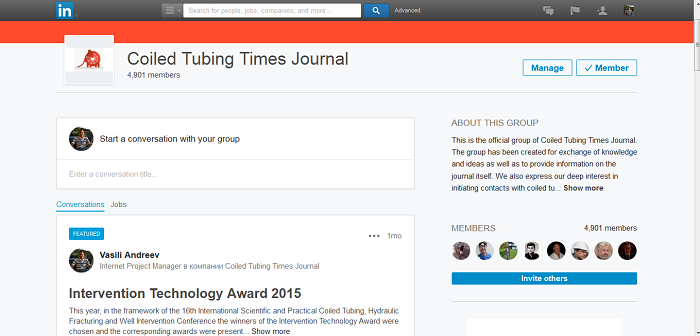- Home page /
- Journal /
- CTTimes in social media /
- Effective Chemical for Dissolving Paraffin and Waxes
Effective Chemical for Dissolving Paraffin and Waxes
Scientific and practical Coiled Tubing Times Journal is an active member of social networks. In particular, the journal has its own page on Twitter (https://twitter.com/cttimesdotorg), a widely known social network that enables users to send and read short messages. On that page one is always able to find links to the most up-to-date news of oil and gas industry and oilfield services. Such an option will be very useful for our readers who often use mobile phones and tablets for surfing the web and accessing the Twitter via a specialized mobile application.
Coiled Tubing Times has its own group on LinkedIn website. LinkedIn is a business-oriented social networking service which allows establishing professional relationships. More than 225 millions of users representing 150 industry segments from 200 countries are registered in the service. The group of our journal (https://www.linkedin.com/grp/home?gid=2244679) is actively developing and growing in a number of participants. Almost 4,500 users from Russia, USA, Canada, Middle East, Latin America and Asia-Pacific region are currently registered as the members of our group.
LinkedIn social networking service allows not only to establish business contacts and find new friends, but also to find answers to the questions you are interested in. A large number of professionals working in oil and gas industry in general and coiled tubing industry, in particular, are the members of our group. You can always count on that your questions will find the proper answers, and you’ll get the information that will be useful for you.
Coiled Tubing Times will publish some of the most interesting and lively discussions started in the Coiled Tubing Times group on LinkedIn. One of such discussions is introduced below.
Abdul Sattar Bugti, Production Engineer at Pakistan Petroleum Limited asks: “Kindly let me know the best appropriate chemical for dissolving paraffin and waxes which are causing restriction in production tubing for running flow control equipment. The chemical will be used via coiled tubing with the help of SpinCat jetting tool to scratch out.”
Here are some of the replies.
Jared Graham: “It seems to me that acidizing the wellbore might be your best bet. Your acid blends will largely depend on the type of formation that you are dealing with. But acidizing with the SpinCat technology should do a nice job of cleaning out the production tubing.”
Michael Lorenson: “Acid, although a good choice for scaling and other solids restricting flow, in sandstone and clay formations can damage the wellbore. Xylenes will loosen up most paraffin and waxing. But they are highly flammable. Check your service companies policies and procedures for this as some companies will not pump flammable fluids or will do it only with low concentrations. Foaming with N2 at higher velocity returns will help as well.”
Michael Prendergast: “Check out ZENEOR non-flammable paraffin remediation.”
Oragui Charles: “Although acid stimulation is a good choice when mixed with appropriate quantity of corrosion inhibitor and some amounts of surfactants as well. We can look at the type of the scale in question as well. The properties of the scale and the height/volume that we are dealing with are of great importance. A good solvent like Xylene, diesel in a 50:50 ratio with a surfactant can as well go a long way to tackle the troublesome scales and paraffin presence in the tubing. These have been used several times on different jobs and for various clients and have been proved ok. Many companies fear a lot about the effect of acid on their tubing. Here we are talking of old tubing, or tubing that has undergone a lot of acid stimulation jobs.”
Perhaps, comments of these specialists will be useful for the readers of our journal.
By Vasili Andreev, Coiled Tubing Times
Note. The opinions of the above specialists do not necessarily represent the opinion of the Editorial Board.
-
12.10.2022
23th International Scientific and Practical Coiled Tubing, Hydraulic Fracturing and Well Intervention Conference
-
16.09.2022
Exec: Gazprom plans to keep investment program for 5 years
-
24.12.2021
Gazprom Neft, Skoltech and the Khanty-Mansi autonomous okrug-Yugra are developing technologies to produce hard-to-recover oil
-
17.12.2021
Gazprom neft establishes Russia’s first test facilities for developing hard-to-recover oil production technologies


